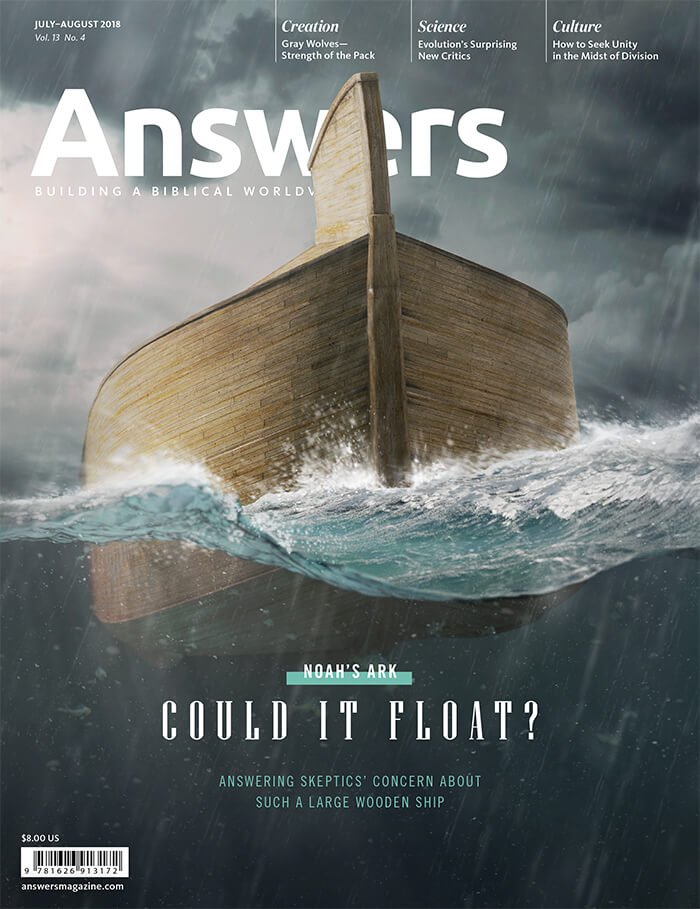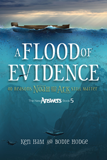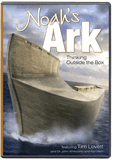How Could Noah’s Ark Survive the Storm?
Skeptics claim that a wooden ship the size of Noah’s Ark couldn’t possibly stay afloat. Did God perform a miracle to keep it from sinking?
“People in the early 1900s built an extraordinarily large wooden ship, the Wyoming. It was a six-masted schooner, the largest ever built. . . . [but] it would twist in the sea . . . and leaked like crazy. The crew could not keep the ship dry, and indeed it eventually foundered and sank; loss of all 14 hands. So there were 14 crewmen aboard a ship built by very, very skilled shipwrights in New England. These guys were the best in the world at wooden shipbuilding, and they couldn’t build a boat as big as the ark. . . . Is it possible that the best shipbuilders in the world couldn’t do what 8 unskilled people, men and their wives, were able to do?”
Bill Nye, the Science Guy
In his widely publicized 2014 debate with Answers in Genesis president, Ken Ham, Bill Nye the Science Guy cited the sinking of the Wyoming as proof that the biblical account of Noah’s Ark is impossible. He was simply repeating one of skeptics’ most common challenges against the Ark’s seaworthiness.
To answer this challenge, some Christians have appealed to God’s miraculous intervention. But is this really necessary?
Before examining the many challenges that large wooden ships must overcome, we need to be careful not to fall into the trap of accepting Nye’s unprovable assumptions. He claimed that the Ark’s eight builders were unskilled. Far too often, Christians go along with skeptical arguments instead of exposing the false premises on which they are constructed. For example, many Christians repeat Nye’s assertion when they happily state, “The Titanic was built by experts, and the Ark was built by amateurs.” But where does the Bible ever tell us that Noah was an amateur or that only eight people worked on the Ark?
We know from Scripture and our own experiences that when the Lord calls a person to a specific task, he will make sure the person has the capabilities and resources to complete the work. Does it make any sense to think God would have called Noah to such a vital purpose if he were inexperienced or incompetent? Noah may have been a highly skilled shipbuilder or he may have hired people who were.
Implicit in Nye’s claim is the notion that ancient people were primitive, yet evidence to the contrary has been found around the globe. In the first several centuries after the Flood, for instance, people built engineering marvels that still stand today, such as the Great Pyramid and Stonehenge.
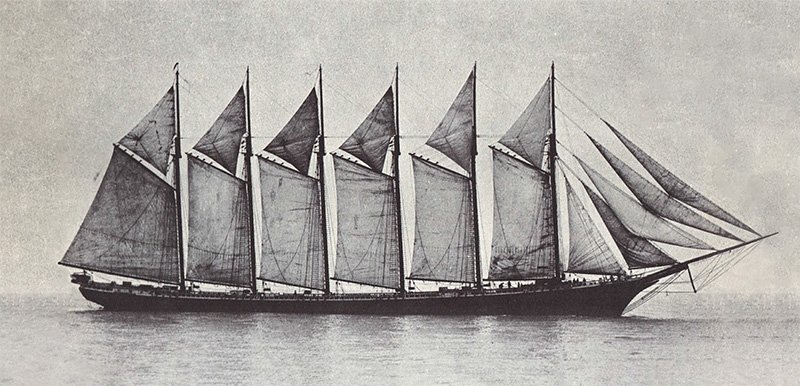
Schooner Wyoming (1909), the largest wooden ship built in modern times, foundered and sank.
Problems for Large Wooden Ships
Bill Nye touched upon just one of the many challenges a large wooden ship must overcome to remain afloat. The ship’s hull is made of long wooden boards, called strakes, which can twist and pull apart under stress from waves, or they can expand when wet and contract when dry.
To minimize these difficulties, the strakes must be joined in ways that allow motion without failure of the joint. Each strake must also be connected in a similar way to those above and below.
When the strakes are securely connected, the ship is said to be tight. This is where the phrase “tight ship” comes from. However, if forces on the hull cause the strakes to slide past each other, a process called slip, then the vessel becomes a “loose ship.”
The problem becomes greater when ships exceed certain lengths. These difficulties are magnified in large ships because the waves and the troughs between the waves create different stresses on different parts of the boat at the same time.
Consider two successive waves about 150 feet apart. If the ship is longer than the distance between these waves, then one end will be struck by the first wave at the same time the other end is struck by the second. As the waves lift both ends of the boat, the middle (called the amidships) is at higher risk of sagging than smaller vessels.
The opposite problem is hogging. This occurs when the ends of the ship are over the troughs, while a wave is lifting the amidships. Can you picture this extra strain? Both sagging and hogging put tremendous stress on a ship’s hull.
But things can get even worse if the vessel is not turned properly into the waves. If a long ship turns at an angle into the waves (called a quartering sea), it can undergo multiple stresses at once. Imagine some of the possibilities. In a quartering sea, the bow (front) of the craft might face stress from one direction, while the stern (back) endures a force from a different direction.
In this situation, the bow may be riding on top of a wave, so the force lifts it straight up. Meanwhile, the current will drive the stern forward at an angle, producing a nasty twisting force (technically called torsion) amidships. Talk about twisting and turning! No wonder the Wyoming sank.
Another rather obvious difficulty for ships, often overlooked when talking about the Ark, is the danger of collisions with rocks on the shore or debris in the water. With the Flood ripping apart the earth and stripping it of all its forests and vegetation, the potential for obstructions in the water is mindboggling. Creation geologists who have studied this issue believe that the raging waters shaved the continents down to their foundations, creating a mixture of rapidly moving boulders, rocks, and debris that could destroy any normal boat trying to stay afloat.
Overcoming Obstacles
With the exception of collision dangers, most modern vessels minimize these risks because their hulls are made of steel. Also, they have engines and a rudder, so they can turn into the waves, where they are safest. Most wooden ships in history have had a method of propulsion and a rudder, too. But as far as we know, Noah’s Ark did not possess a moveable rudder or any means of self-propulsion.
So what did Noah do? To survive the Flood, the Ark must have been engineered to account for these risks. The box-shaped Ark so often depicted in picture books would have been at a major disadvantage. Without any mechanism to turn it into the waves, a box-shaped vessel would have broached (turned side-on to the waves) repeatedly, and the battering waves would have put enormous stress on the hull, making an unbearably rocky ride for its occupants.
Thankfully, the Bible does not force us to view the Ark as a giant box. While it gives us the overall dimensions, it does not tell us the shape. In the past, some people have asserted that the Hebrew word translated Ark (teyvah) means “box”; but this is inaccurate.
The full-size Ark reconstruction recently opened at the Ark Encounter theme park in the United States took all these nautical factors into account. Mechanical engineer Tim Lovett spent years researching ancient shipbuilding techniques and consulting with naval architects to develop a design that could survive the many dangers mentioned earlier.
Designing an Ark that would continually face the waves at a right angle was absolutely essential. Lovett concluded that one simple solution for Noah would be to place two prominent structures on the exterior. On the bow he could put a large sail-like structure, though contrary to some assumptions, this is not a sail for propulsion. Instead, this rigid “bow fin” would catch the wind and constantly turn the stern into the waves, similar to the way wind turns a weather vane. In addition to a bow fin, a kind of skeg, or large fin-like projection, at the bottom of the stern would restrict side (lee) motion, thus keeping the vessel rotated to face the passing waves (called a following sea).
Similar structures were built on ancient ships. For example, the famous Greek triremes boasted one end turned upward, like a small rigid sail, and a projection for ramming at the opposite end, similar to the skeg. Unlike the Ark, however, these ships were propelled through the water by the wind and oars. So the rigid sail rose from the stern and the “skeg” cut into the waves at the bow, similar to the bulbous bow seen on many modern ships.
Preventing sagging and hogging on a large wooden vessel is perhaps the main challenge. So Tim Lovett proposed that Noah could have built three keels running lengthwise along the ship’s bottom. Three massive beams, along with an intricate system of sturdy timbers running up to the roof, would allow the ship to counteract the tremendous stresses of a long voyage. Having three keels instead of just one, as seen on most ships today, would also allow the Ark to be constructed without supports and to remain upright after it landed.
What about the danger of the planks sliding? Lovett realized that skilled shipbuilders knew how to design a multilayered covering for the hull. The outer layers are “sacrificial,” meaning that they are not necessary for structural integrity but merely absorb blows from obstructions and wear away, without damaging the underlying layers.
Lovett borrowed his design for the strakes from ancient shipbuilders. The Greeks and Romans became masters of the sea because they had perfected a technique known as mortise and tenon planking. These interlocking pieces kept the ships tight by securing each plank to the strakes (planks) above and below it. Chinese vessels from the 1400s used multiple layers of planking. Each successive layer of planking dramatically increased their resistance to stress. Both ancient and modern builders of wooden ships have used another technique to prevent leakage, which Noah could have used. They pound wooden pegs, called trunnels, into holes drilled into the strakes. Along with holding the planks in place, the trunnels also swell when the ship is in the water, thus providing an extra measure of waterproofing.
The Bible specifically says that God instructed Noah to coat the inside and outside of the Ark with pitch. Throughout history, builders of wooden ships have done this on the outside to prevent leakage. The internal pitch would provide an extra barrier against leakage and, depending on when it was applied, it may have acted as a preservative during the extended construction period.
These are just some of the technical details about ship construction that Tim Lovett considered to show how the Ark could be a tight ship.
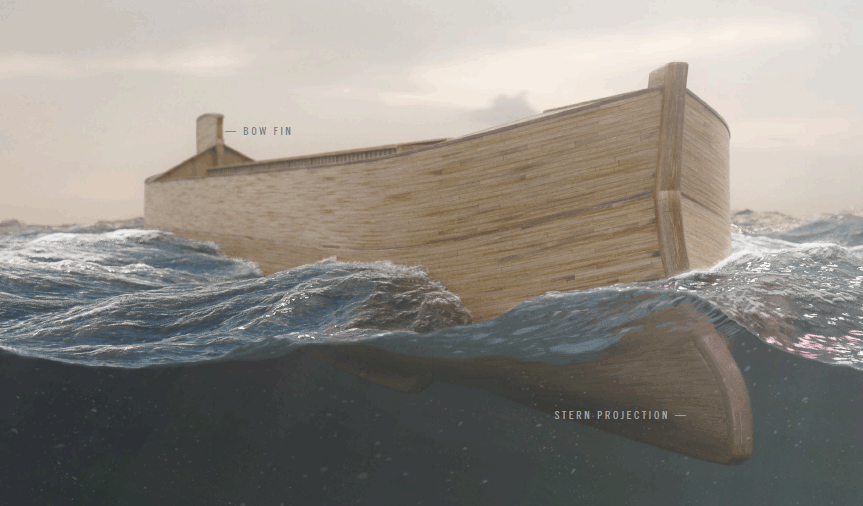
Noah could have added a few basic features to help the Ark avoid destructive waves.
Bow Fin—Fixed “Sail”
Noah could have added a fixed “sail” on the upper bow of the Ark so the wind could turn the ship into the rough waves.
Stern Projection—Fixed “Rudder”
Noah could have added a fixed “rudder” at the lower stern of the Ark to keep the ship turned into the rough waves.
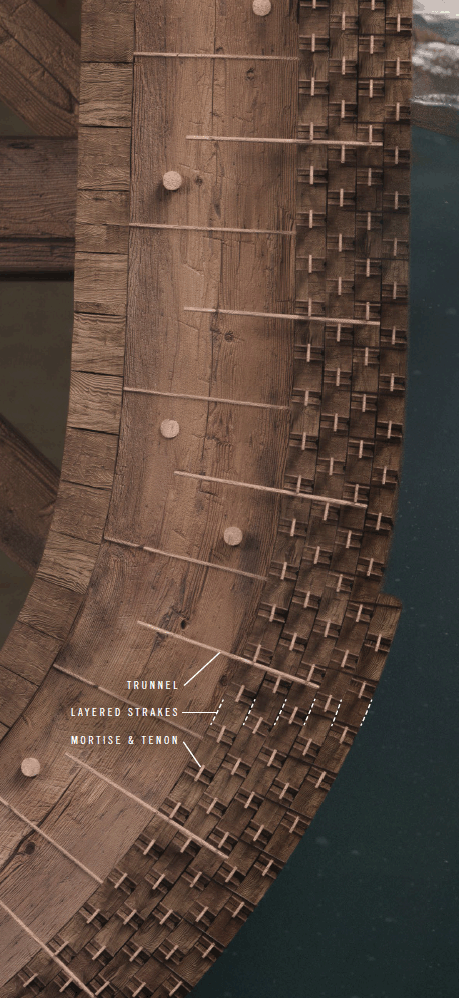
Noah could have added a few basic features to keep the ship watertight.
Layered Strakes—Overlapping Planking
Multiple layers of overlapping strakes (planks) would give the Ark more durability. The outer layers could wear away without damaging the underlying layers.
Pitch—Waterproofing
Shipbuilders have always covered a ship with pitch to prevent leakage. But God commanded Noah to coat the inside too, which would have improved waterproofing.
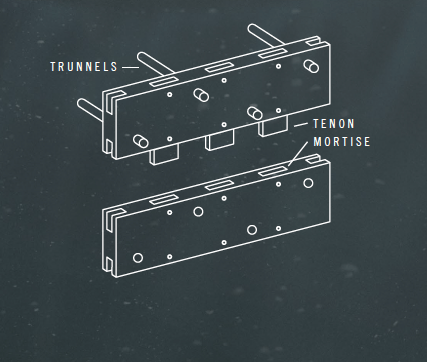
Mortise & Tenon—Interlocking Joints
Planks can be “snapped” together with interlocking joints (tenons) that slip into matching holes (mortises) cut into each plank.
Trunnels—Wooden Pegs
Holes can be drilled into planks and wooden pegs pounded into the holes to hold the planks together. These pegs swell in the water and close any gaps.
Did It Float?
We need not appeal to God’s miraculous power to explain how the Ark survived the Flood.
The Bible explains that only eight people survived the Flood in Noah’s Ark (1 Peter 3:20). So, yes, the Ark floated and kept its human and animal passengers safe from the most devastating catastrophe this world has ever known. We need not appeal to God’s miraculous power to explain how it survived the Flood. Instead, we can trust that God chose the man he had prepared to carry out this vital task and that righteous Noah was capable of obeying God’s instructions wisely.
Large wooden ships like the Ark certainly have many design challenges to overcome, but God did not give Noah an impossible task. The Lord knew such a boat could be constructed, and although Scripture does not indicate that he gave Noah all the solutions to these challenges, it is quite logical that through careful planning and ingenious design, Noah could lead the building of a ship that met God’s parameters to protect its precious cargo.
Bill Nye referred to the Wyoming as proof that large ships can’t handle the open sea, but he left out some important details.
- The Wyoming had six large masts, unlike the Ark, which had none. The tall masts and large sails significantly increased the stress on the hull and introduced major stability issues that the Ark did not face.
- The Wyoming remained afloat for over 14 years. While it was not as large as Noah’s vessel, the fact that a long wooden boat floated for so long should make us pause before proclaiming that Noah’s Ark could not survive five months before landing on the mountains of Ararat.
- Investors built the larger wooden sailing ships in the 19th and early 20th centuries cheaply and quickly to serve as commercial workhorses. They shuttled goods back and forth, and they were expected to last only 10–15 years.
- Furthermore, these ships generally had a single-layer hull braced by iron straps, and the strakes were held together by caulking. With great stresses on larger ships, it did not take long for the planks to slip and leak.
Related Videos
Noah’s Ark: Thinking Outside the Box Excerpt
Answers Magazine
July–August 2018
Skeptics claim that a wooden ship the size of Noah’s Ark couldn’t possibly stay afloat. Did God perform a miracle to keep it from sinking? How could Noah’s Ark survive the storm?
Browse IssueRecommended Resources

Answers in Genesis is an apologetics ministry, dedicated to helping Christians defend their faith and proclaim the good news of Jesus Christ.
- Customer Service 800.778.3390
- Available Monday–Friday | 9 AM–5 PM ET
- © 2025 Answers in Genesis



